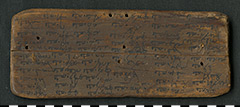SB III 6219 (P. 10506)
Mental arithmetic is difficult. Cheat sheets are therefore popular. Another way to avoid having to do mathematical calculations over and over again is to use boards with lists of multiplications and divisions that you can look up quickly. The wooden tablet described here is probably such a memory board.
This wooden tablet, dating from the 7th century AD, was acquired by Otto Rubensohn for the Berlin Papyrus Collection in 1904 and contains a list of divisions in Greek in six columns on the front (recto) and some multiplication tasks and one addition task in two columns on the back (verso). Two holes in the centre of the upper edge are conspicuous. These were probably used to connect other wooden boards to this board. Perhaps the board could also be hung up. The holes in the middle of the wooden board still contain remnants of the original threads, which were probably intended to hold the panel together after it had been broken in two.
In the mathematical tasks on both sides of the board, Greek numerals are used that differ from our present-day numerals. For the Greek numerals, the letters of the alphabet were used, i.e. α = 1, β = 2, γ = 3, etc. For some numerals there were special symbols that did not appear in the alphabet, such as the stigma (ϛ) for the 6. Unlike our way of writing numerals today, there were separate letters for the tens, hundreds, etc., which were not identical to the ones. Thus, for the tens, not the ones and a zero were used, which the Greeks did not even know yet, but a letter of the alphabet, i.e. ι = 10, κ = 20, λ = 30, etc. In this way, they knew directly that it was a ten. For the number 28, one therefore used the two Greek letters κ and η with an imaginary plus in between and wrote it as κη. The hundreds etc. functioned according to the same principle.
The divisions on the recto are classified as easy to moderately difficult. In the first five columns, the scribe of this board has listed the halves of the numbers from 1 (1/2) to 10,000 (5000). From column IV onwards, the writer starts with something new. Between line 6 and line 7 there is a dividing line indicating that a new list has been started. Namely, two-thirds of the numbers 1 (2/3) to 300 (200) are now enumerated. What is striking about this board are the titles with which the lists are introduced: „half“ for the first list and „two-thirds“ for the second. The calculations on the verso are clearly more difficult. First, the scribe calculated some multiplications of larger numbers, then added up several complicated fractions to the right.
The writing is very neat and tidy and is most likely by a person with a more practised hand than that of a child. It is speculated that the scribe of these lists was an experienced student of about 14 years of age. However, no one knows whose wooden board this once was. Overall, the writing is too neat for a mere school assignment. Presumably, this board was a kind of memory board to quickly look up the results of the divisions, multiplications and addition described. Moreover, wood was rare in Egypt and therefore expensive and difficult to reuse as a writing medium.
Wooden tablets like these are unfortunately not found very often. Most of the school related tasks that the Berlin Papyrus Collection possesses are excerpts from Homer’s Iliad and other famous literary works and wise sayings. Mathematical tasks, on the other hand, are rare.



